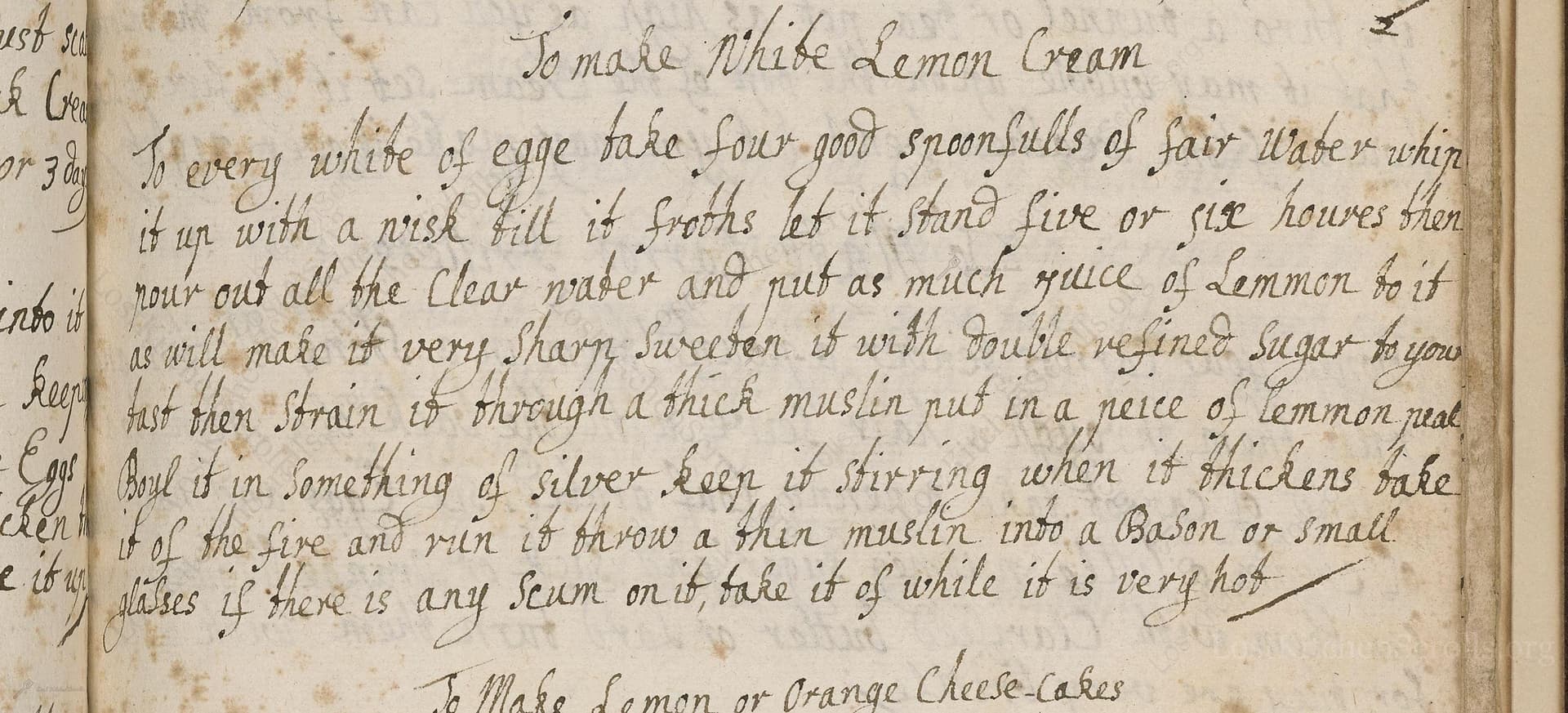To Make Whibe Lemon Cream
From the treasured pages of Receipt book
Unknown Author

To Make Whibe Lemon Cream
"to every white of egge take four good spoonsfulls of fair water whip it up with a wisk till it froths let it stand five or six houres then pour out all the clear water and put as much juice of Lemmon to it as will make it very sharp sweeten it with double refined sugar to your tast then strain it through a thick muslin put in a peice of lemmon peal Boyl it in something of silver keep it stirring when it thickens take it of the fire and run it throw a thin muslin into a Bason or small glases if there is any scum on it, take it of while it is very hot"
Note on the Original Text
Like most early modern recipes, this is written in continuous prose without measurements familiar to today’s cooks, relying on experience and taste (‘as will make it very sharp’) rather than unit-based precision. Spelling (e.g., ‘Whibe’ for ‘White’) and punctuation are fluid; capitalization and syntax vary widely, reflecting changing conventions. Instructions assume a familiarity with kitchen practices—straining, whipping, boiling—common to the era’s home cooks.

Title
Receipt book (1700)
You can also click the book image above to peruse the original tome
Writer
Unknown
Era
1700
Publisher
Unknown
Background
A delightful glimpse into the kitchens of the early 18th century, this historic culinary manuscript promises a feast of recipes, remedies, and perhaps a pinch of mystery. Expect both practical fare and elegant inspiration for the curious cook.
Kindly made available by
Folger Shakespeare Library
This recipe comes from around 1700, a time when refined desserts were becoming increasingly fashionable in English households. Whipt creams—delicate, frothy confections—were a popular way to showcase culinary skill and the refinement of ingredients like sugar and citrus, both luxuries at the time. Recipes like this were found in manuscript books kept by well-to-do families, particularly among women who exchanged sweetmeats and pudding preparations as symbols of hospitality and status. The ‘white lemon cream’ was likely served at the end of a meal or at social occasions, showing off both the cook’s ingenuity and a taste for the sharp-sweet flavors that became a hallmark of early modern desserts.

The original recipe would have used a hand whisk (or bundled twigs) to froth the egg whites—a vigorous process before the age of electric mixers. Silver pans were prized for their resistance to acidic lemon, but a ceramic or glazed earthenware pot could also be used. Straining was done through muslin, a fine cotton cloth, neatly folded on a wooden frame or simply held over a bowl. To serve, small glass ‘custard cups’ or shallow basins were used, allowing guests to admire the pale, set cream.
Prep Time
10 mins
Cook Time
5 mins
Servings
2
We've done our best to adapt this historical recipe for modern kitchens, but some details may still need refinement. We warmly welcome feedback from fellow cooks and culinary historians — your insights support the entire community!
Ingredients
- 1 egg white
- 1/4 cup (4 tbsp) fresh water
- 2-3 tbsp (1-1.5 fl oz) fresh lemon juice (about 1 lemon)
- 2-3 tbsp (1-1.5 oz) superfine caster sugar (to taste)
- 1 strip fresh lemon peel
- Muslin or cheesecloth for straining
Instructions
- To recreate this charming 18th-century Whipt Lemon Cream, begin by whisking the whites of eggs with fresh water at a ratio of 1 egg white to 1/4 cup water.
- Use an electric mixer or hand whisk until a full, frothy foam forms.
- Allow the mixture to sit for 5-6 hours; this settles the fluff and clarifies the liquid below.
- Gently pour off the clear liquid, discarding the foam, then stir in enough fresh lemon juice to make the liquid noticeably tart (roughly 1 lemon’s juice per egg white), and sweeten generously with superfine (caster) sugar to taste.
- Strain the blend through a double layer of muslin or cheesecloth, add a strip of lemon peel, and transfer to a non-reactive saucepan (silver if you have it, or a heavy-bottomed pan).
- Gently heat, stirring constantly, until the mixture thickens slightly.
- Remove quickly from the heat, strain again into serving bowls or glasses, and skim off any remaining froth or scum while still hot.
- Serve chilled for a refreshing, silken dessert.
Estimated Calories
45 per serving
Cooking Estimates
You will whisk and rest the egg white mixture for several hours, then cook briefly to thicken. Most of the time is waiting for the mixture to settle, not active work.
As noted above, we have made our best effort to translate and adapt this historical recipe for modern kitchens, taking into account ingredients nowadays, cooking techniques, measurements, and so on. However, historical recipes often contain assumptions that require interpretation.
We'd love for anyone to help improve these adaptations. Community contributions are highly welcome. If you have suggestions, corrections, or cooking tips based on your experience with this recipe, please share them below.
Join the Discussion
Rate This Recipe
Dietary Preference
Main Ingredients
Culinary Technique
Occasions

Den Bockfisch In Einer Fleisch Suppen Zu Kochen
This recipe hails from a German manuscript cookbook compiled in 1696, a time whe...

Die Grieß Nudlen Zumachen
This recipe comes from a rather mysterious manuscript cookbook, penned anonymous...

Ein Boudain
This recipe comes from an anonymous German-language manuscript cookbook from 169...

Ein Gesaltzen Citroni
This recipe, dating from 1696, comes from an extensive anonymous German cookbook...
Browse our complete collection of time-honored recipes



